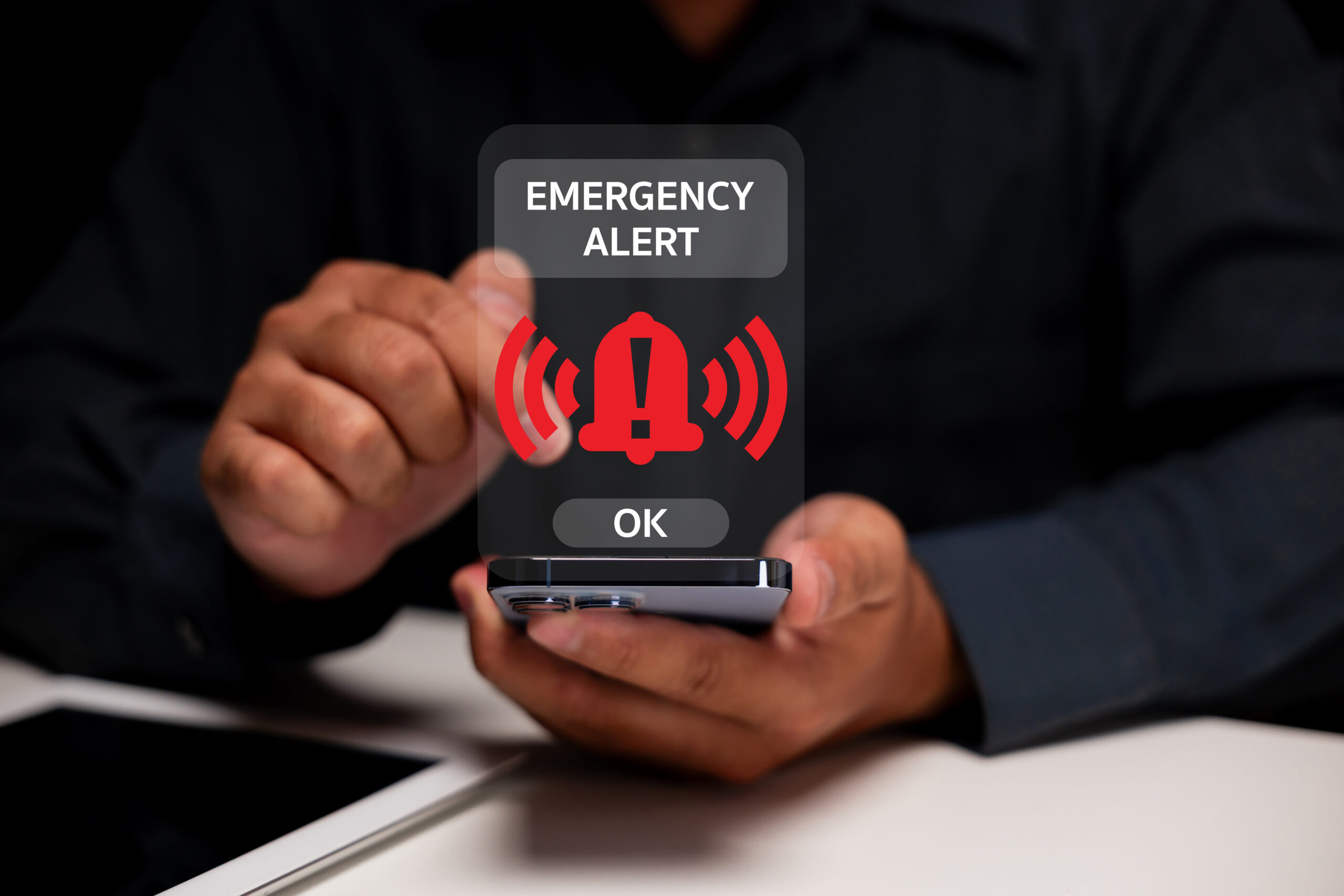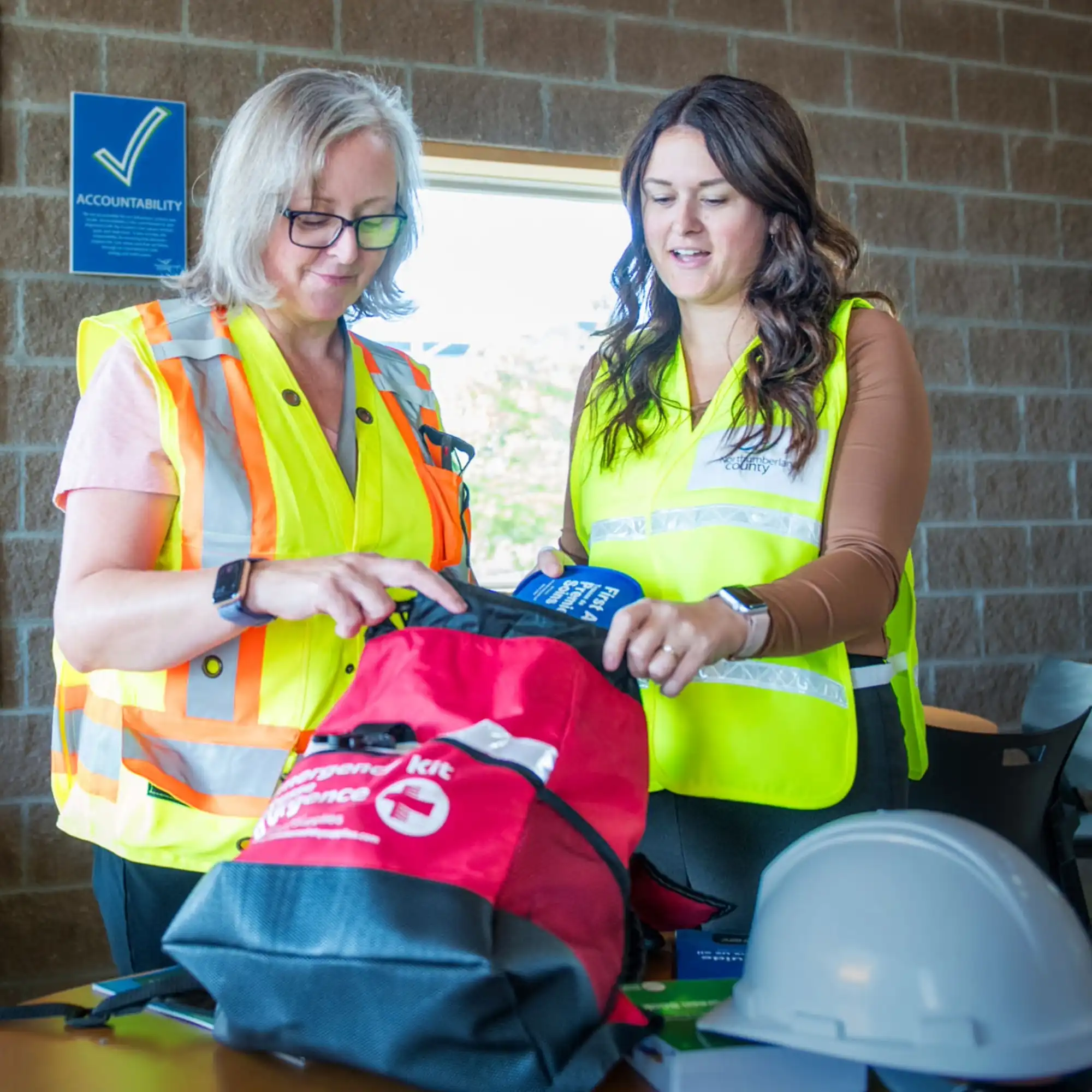
Emergency Preparedness
Emergency preparedness is everyone’s responsibility. Northumberland County, lower-tier municipalities and residents each have roles to play in preparing for emergencies.
In an emergency
If you are in an emergency, you should follow these guidelines:
- Dial 911 for police, fire, ambulance and paramedic services
- Remain calm
- Ensure your safety and the safety of others before approaching the scene
How to be prepared in an emergency
Here are some tips to help prepare in case of an emergency.
Learn CPR, First Aid and defibrillation – you never know when you may need it. Cardiac arrest can strike at any time, without warning. Early CPR can significantly increase the chance of survival for someone in sudden cardiac arrest. Many agencies offer CPR, defibrillator and First Aid training (Northumberland County does not endorse any one particular agency):
Make sure to have a fully equipped first aid kit at home, at the cottage, in your car and at your place of business.
Make sure to have you and your family’s health information and medication list readily available for paramedics.
For more information about what to do if you are requested to leave your home during an emergency, please visit our Evacuations page.
Personal preparedness
All residents should be prepared to be self-sufficient for up to three days in the event of an emergency. Learn how you can prepare for an emergency by building emergency kits.
View the infographic below to learn more:

Emergency Preparedness Guide
Emergency preparedness tips
Learn more about how to be prepared and stay safe during extreme weather events or other safety risks. Follow us on Facebook for monthly emergency preparedness tips.
What is a cyberattack?
A cyberattack is a malicious, deliberate attempt to breach a digital information system and gain information from a business or individual. This can include email or internet fraud, identity fraud or theft of finances.
What are the threats?
- Phishing: The practice of sending fraudulent emails that resemble emails from reputable sources, aimed at stealing sensitive data
- Malware: Malicious software designed to disrupt, damage or gain unauthorized access to a computer system
- Ransomware: A type of malware designed to extort money by blocking access to your computer system until ransom is paid
- Social engineering: A tactic used to trick people into revealing sensitive information
How can you protect yourself from a cyberattack?
- Be cautious when you receive messages asking for personal information
- When possible, verify any requests for personal information
- Remember that most legitimate organizations will not ask for personal information through text message or email
- Call your bank to verify any messages received requesting personal information or for you to take action by clicking a link
- Create a unique password for every account and change them frequently
- Do not use any personal information such as your birthday in your passwords
- Limit the amount of personal information you share online
- Secure all your devices (cell phone, laptop, tablet) with a password and multi-factor identification, in case your device or log-in information gets lost or stolen
- Watch out for unknown emails or webpages — interacting with unknown sources can put your information at risk and download viruses on to your device
A drought is a period of unusually dry weather that lasts long enough to produce a serious water shortage, otherwise known as a hydrologic imbalance. This can lead to issues like crop damage and poor water quality.
Water conservation restrictions may be put in place during a drought. These may include actions like:
- Watering lawns and washing cars on odd or even days of the week, at night or on weekends.
- Limiting or prohibiting water use or require hand-watering instead of sprinkler systems that use large amounts of water.
While watching our water use is especially important during droughts, below are a few tips on how to conserve water year-round:
- Never pour water down the drain when it could have other uses, such as watering your plants.
- Take shorter showers and don’t let the water run while brushing your teeth, washing your face, or shaving.
- Only operate dishwashers and washing machines when there is a full load or use the light wash feature.
- When buying new appliances consider more energy/water efficient options.
- If washing your car use a shut off nozzle on your hose so that water only flows when in use and turn off the faucet when you are done.
- Avoid overwatering your lawn. It only needs to be watered every 5 to 7 days in the summer and 10 to 14 days in the winter.
- Make sure to cover pools and spas when not in use to avoid evaporation.
Floods are most often caused by heavy rain, melting snow or high lake levels. They can happen at any time of year, in any area. Here are some tips to help protect your home and family during flooding.
Inside your home
- Store any personal belongings in sealed bins
- Move keepsakes out of the basement
- Test sump pumps regularly and install a backup system (generator)
Outside your home
- Remove anything that could cause danger during the flood
- Secure outdoor furniture
- Maintain water drainage system
View an infographic: How to protect your home from flooding
If you are not instructed to evacuate during a flood, consider these safety precautions:
- Avoid travelling on roads near water
- Don’t drive or walk through moving water
- Keep kids and pets away from floodwater
The flu is a contagious virus that anyone can get, but there are several things you can do to avoid catching it or spreading it to others:
- Get your flu shot
- Wash your hands
- Cover your mouth when you cough
- Don’t touch your face
- Stay at home if you are sick
- Clean and disinfect surfaces and shared items
Forest fires can be dangerous to people and property. Being ready in advance and knowing what actions to take can help to better protect you.
If you are indoors
- Move away from outside walls
- Close doors but leave them unlocked
- Close windows, vents, and blinds
- Remove lightweight curtains
- Turn off air conditioning
- Keep all family members and pets together
- Have a flashlight and extra batteries in case the power goes out
If you are told to leave your home
- Choose a route away from fire hazards
- Watch for changes in speed and direction of fire and smoke
- Wear long sleeves, pants and closed toed shoes to protect you again sparks and ashes
- Take your pets with you
- Tell someone when you leave and where you are going
Here are the seven steps to respond to hazardous spills:
- Identify the substance and determine the risk
- Protect yourself
- Stop the spill
- Contain the spill
- Minimize the risk
- Clean up the spill
- Decontaminate
Summer is the season of extreme heat weather events. Hot weather can be a risk to health for everyone, but children and seniors are often more vulnerable. Extreme heat can put you at risk of heat exhaustion or heat stroke. Make sure you know the signs and symptoms of heat-related illnesses.
Signs of heat exhaustion
- Heavy sweating
- Cold, pale, clammy skin
- Dizziness
- Weakness or fatigue
- Headache
- Nausea or vomiting
Signs of heat stroke
- Confusion or altered mental state
- Body temperature over 104°F (40°C)
- Hot, dry, flushed skin
- Nausea and vomiting
- Rapid pulse
- Quick, shallow breathing
- Headache
What to do if someone is suffering from heat exhaustion
- Rest in a cool place
- Sit or lie down
- Drink cool fluids
- Soak in a cool bath, take a cold shower or put towels soaked in cool water on your skin
- Loosen clothing
What to do if someone is suffering from heat stroke
- Call 911 and stay with the person until help arrives
- Move out of the heat immediately
- Cover the person with cool wet cloths or soak in a cool bath
Protect yourself and prevent heat-related illnesses
- Try to stay indoors to limit sun exposure
- Stay hydrated and drink water, even if not thirsty
- Wear light, loose-fitting clothing
- Stay out of direct sunlight
- Use sunscreen and lip balm with SPF of at least 15 — apply sunscreen 20 minutes before going outside
- Wear ultraviolet- (UV) absorbent eyewear (sunglasses, shades, etc.)
- Wear a hat or use screens or umbrellas to create shaded areas
- Use fans and air conditioning
- Never leave anyone in a parked car
- Take it easy during the hottest parts of the day
- Be cautious if you are in an increased risk group
- Take cool showers or baths
- Stay on lower floors if you do not have air conditioning
Learn more
View the infographics below to learn more:
To keep everyone safe, it is important that everyone knows what to do and where to go when the smoke alarm sounds. Take some time to make a home fire escape plan with your family.
- Draw a floor plan of your home – include every level
- Include all possible emergency exits – draw all doors, windows, and stairways
- Show two ways out of every room, if possible – the door will be the main exit from each room but if it is blocked by fire or smoke, you will need to choose another option, such as a window
- Identify anyone who needs help to escape – decide in advance who will be the one to help the young children or the older adults in the household
- Choose a meeting place outside that is a safe distance from your home and that everyone will remember
- Call the fire department once you are outside of your home. Don’t waste valuable seconds calling 911 from inside – make sure that your family is out safely and call from a cellphone or a neighbour’s phone
- Practice the escape – walk through the escape routes so everyone is familiar with them
Learn more
Power outages can occur during severe weather including winter storms, high winds, thunderstorms, and heat waves. These outages can be over just as quickly as they happen, but others can last much longer — up to days or even weeks. During an outage, you may be left without power or heat, which can pose serious challenges. Make sure you take the time to prepare for a power outage with three basic steps:
- Find out what to do before, during and after a power outage.
- Make an emergency plan for yourself or your family, so everyone knows what to do or where to go in case of a power outage.
- Prepare a 72-hour emergency kit to ensure you can be self-sufficient for three days without power.
Keeping schools safe is everyone’s responsibility, here are some tips to keep you and your loved ones safe:
- Review your family’s emergency plan and ensure your emergency preparedness kit is up to date.
- Be aware of school emergency procedures.
- While driving, watch for children walking, cycling and coming off school buses.
- Review bus safety.
- Obey crossing guards.
- Be aware of allergies and pack school safe lunches.
Don’t let slips trips and falls catch you off guard, here are some steps to help prevent them:
- Stay on designated sidewalks, especially those treated for ice in the colder months.
- Take shorter steps and slow down your pace to maintain balance.
- Wear footwear with ample traction or consider spikes for added grip.
- Stay focused when walking by putting away distractions like your phone.
- Try not to carry heavy items that could throw off your balance.
Snowstorms, ice and extreme cold in the winter can pose a risk when precautions are not taken. Take the following tips into consideration during winter:
- Stay dry – Avoid wearing wet clothing in extreme cold. You are more likely to develop hypothermia if you are cold and wet.
- Take care when outdoors – Check the weather before heading out for the day. Warm up by taking breaks in areas such as malls or libraries.
- Take care while walking on ice – Take your time while waking in icy conditions. Many winter injuries come from slips and falls on ice-covered surfaces. Make sure steps and walkways are clear of ice and snow.
- Travel cautiously – Avoid travelling in low visibility or ice-covered roads. Make sure your vehicle is cleared of all snow and ice so you can clear visibility. For more information, read our winter driving tips below.
It is important not to underestimate the power of thunderstorms, as they can carry the risk of:
- Lightning strikes
- Hail
- Flash floods
- High winds and potential for tornadoes
Preparing for a storm
- Trim branches and cut down unstable trees
- Keep gutters and drains clear
- Keep your roof in good repair
- Have an emergency kit ready ahead of time
During a storm
When thunder roars, stay indoors!
If you are indoors
- Stay away from glass doors, windows or skylights — strong winds can shatter them
- Avoid running water in your house or taking showers and baths during a storm, as lightning can enter through pipes
- Unplug appliances and TVs
- Use a battery-powered radio to listen for weather updates
- Try to stay indoors during a storm and 30 minutes after the last rumble of thunder before going outside
If you are outdoors
- If you hear thunder, that means the lightning is close enough to be dangerous — try to find shelter in a building or vehicle
- Avoid water, high ground, isolated trees and power lines
- If there is no shelter close by, go to a low-lying area away from tall trees
Ontario averages around 12 tornadoes a year, usually between May and September. A tornado is a powerful rotating column of wind that can hurt people and damage property. Large thunderstorms can create many tornadoes. They can appear after a heavy rain or hail, in the sky that is green, yellow or black. Environment Canada will issue a warning when tornados are looming or already detected.
Safety tips for windstorms or tornadoes
- Be aware of weather conditions and warnings
- Seek shelter immediately if a warning has been issued
If you are indoors during a tornado
- Go to an underground shelter, basement or safe room
- If you do not have basement, go to the centre of an interior room on the lowest level of your home, away from corners, windows, doors and outside walls. Have as many walls as possible between you and the outdoors.
- Get under a sturdy piece of furniture
- Do not open windows
If you are outdoors during a tornado
- Get inside before you see the tornado — do not wait until you see it
- If you cannot get inside, lay flat in a ditch and cover your head with your hands
- Do not go under an overpass or bridge – a low, flat area is safer
Be prepared and stay safe while driving in winter weather:
- Use winter tires for better traction in snow, slush and icy conditions
- Check air tire pressure frequently, as it decreases in cold weather
- Make sure to have a car survival emergency kit in your car
- Keep these tips in mind if your car gets stuck in snow:
- Avoid spinning your tires
- Keep the wheels straight
- Dig out snow from around your tires
- Carefully rock you car
- Use floor mats to gain traction
- For more tips on how to drive safely in winter weather and for information about our winter road operations, visit our Snow Plowing page.
Car emergency kit
It’s crucial to ensure you have an emergency preparedness kit in your vehicle so you’re ready for any situation. Make sure your car emergency kit is well-stocked with the essentials below:
- Basic supplies including a first aid kit, flashlight and multi-tool
- Keep non-perishable snacks and bottled water on hand
- Small shovel
- Matches
- Candle in a deep can
- Extra blankets or clothing for cold conditions
Download the What3Words app
Emergency services providers in Northumberland are encouraging people to download the what3words app, which uses an innovative grid-based address system to help first responders pinpoint a caller’s exact location and reach them with minimal delay.
what3words is being adopted by emergency services around the world as a tool to dispatch first responders to the precise location of a caller in need of help. 9-1-1 callers simply give their what3words address from the app, and first responders will immediately be dispatched to their exact location. Every 3-metre square in the world has been given a unique combination of three words: a what3words address that never changes. For example:
- ///plopped.legions.dogged will deliver you to Presqu’ile Point Lighthouse in Brighton
- ///study.swirly.reach is the unique address for a 3-meter square of waterfront along Port Hope’s West Beach
The app works both on- and offline, with the offline functionality making it ideal for use in rural areas that might have a poor internet connection, such as remote nature areas that are enjoyed by hikers and tourists. All the app requires to display a what3words address is a GPS signal, with a phone’s location services switched on and a clear line of sight to the sky for a GPS lock.
The free what3words app can be downloaded from app stores for iOS and Android.

Alert Ready Emergency Alert System

What we do
Even in the most prepared communities, emergencies can happen at any time. Northumberland County and our member municipalities are responsible for identifying hazards in our community and creating response plans to help keep residents and visitors safe.
During an emergency, the County assists local municipalities by working with police, fire, paramedics and other emergency responders. If an evacuation is required, we may open an emergency reception or evacuation centre to support residents who had to leave their homes.
Farm 9-1-1 signs
If you own vacant agricultural land, you are encouraged to have the entrances evaluated for a civic address and 911 sign so first responders can easily locate and access the property in case of an emergency.
Applying for a civic address and 911 sign
Each municipality in Northumberland has its own requirements for a property entrance to qualify for a civic address, and its own fee structure for assessment and signage installation. To apply for an address and sign, please contact your local municipality using the contact information below.
The municipality will assess the safety and suitability of the property entrance. If the entrance meets the requirements, they will work with you to install a 911 sign.
